The Latest News and Views about ANTINOUS the GAY GOD
Compiled and Updated
By
Hernestus, Priest of Antinous
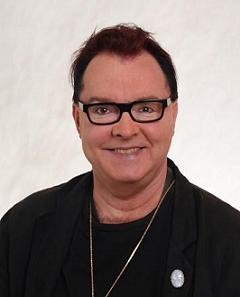
DECEMBER 30th 2008
The Latest News and Views about ANTINOUS the GAY GOD
Compiled and Updated
By
Hernestus, Priest of Antinous

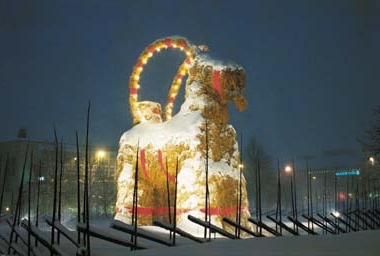
Maybe it is only coincidence -- but the Capricorn New Moon on Saturday coincided with the burning of the Gavle Julbocken -- the Gavle Yule Goat -- which has become something of a Yuletide arson tradition in the Swedish city of Gavle.
The Yule Goat is the Swedish version of the Alpine region's Krampus -- Santa's dark helper derived from Pan, Cernunnos and an assortment of other pre-Christian deities and mid-winter spirits. In English-speaking countries, all that remains of Julbocken or Krampus is the flying reindeer who pull Santa's sleigh.
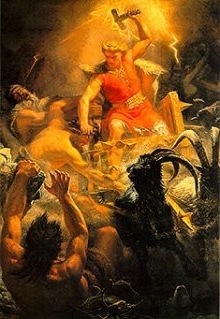
The 13-meter-high (43 foot) goat in Gavle was supposed to be lighted officially amid fireworks at midnight on New Year's Eve. But vandals torched it on Saturday. The firebug vandals were acting in a kind of a tradition of their own since the Julbocken has been torched 23 times since it was first erected in 1966. And on the few occasions when it has not been put to the torch, the Straw Goat variously has been hit by a car and had its legs cut off.
Each year the people of Gavle build the straw goat, a traditional Scandinavian symbol of the Yule season dating to pagan times when Thor's chariot was drawn by sacred goats. But since the straw effigy tradition began 43 years ago, it has spawned the sport of Straw Goat Torching. Fueled by the Christmas spirit -- which is to say by lots of alcohol -- young men take dares on who can torch the goat. Bookies in Stockholm take bets each year on how long the good citizens of Gavle will be able to protect their beloved Julbocken from lager louts armed with cigarette lighters.
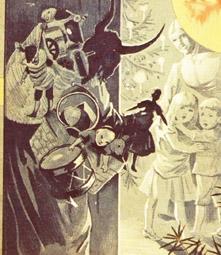
Despite intense surveillance by police and a round-the-clock webcam, Saturday's vandals got away without being identified. Actually, the vandals are rarely ever caught, though in 2001 a 51-year-old American tourist spent 18 days in jail after being convicted of setting it alight. In 2005, it was torched by two arsonists dressed as St. Nick and a Gingerbread Man.
So no one was surprised Saturday when the giant straw goat mysteriously burst into flames right under the watchful eyes of police officers. The official webcam, called the "Bockenkamera" (Goat Cam), caught the conflagration on film, which you can see in the YouTube video below.
The goat is the sacred animal of Thor, of course. Sacred Goats pull Thor's heavenly chariot. In earlier centuries, young men would dress up in furs and wear goat horns on their heads and roam the streets in a drunken Yuletide revelry reminiscent of wassailing or Trick-'r'-Treating.
Just like the young men who dress up as Krampus in Alpine regions, these Julbocken youths would chase girls and attempt to hit them with switches or straw brooms.
The ancient tradition is also very reminiscent of the Lupercalia in Ancient Rome, when virile young men would run through the streets of Rome wearing wolf pelts and would try to catch girls and lash them with rawhide strips.
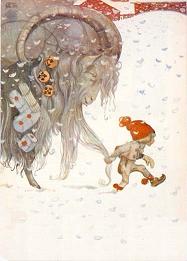
In Sweden, it was the horned Julbocken who visited children at the Yule Solstice, rewarding the good kiddies with toys and sweets, and scaring the hell out of naughty brats.
The Julbocken was accompanied by a lively little elf. Eventually, the roles were reversed and the Julbocken became the assistant to the lively old elf, who morphed into Father Christmas.
All of these traditions -- from Halloween through Mardi Gras -- are ancient winter fertility rites aimed at honoring the wild "horny" gods.
Nowadays, Swedes use straw goats as Christmas tree ornaments.
And if you think a Christmas Goat is strange, then you have clearly never heard the tale of the Christmas Spider who worked a miracle for a poor little girl and her starving family. In Central Europe, people put spider ornaments on their Christmas trees.
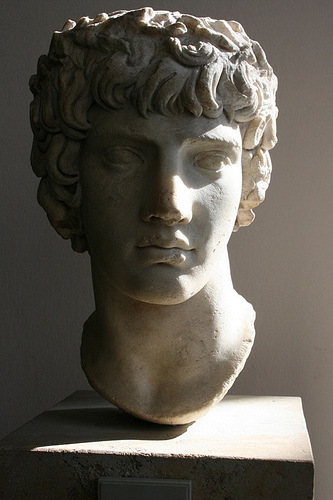
In Honor of the December 25th commemoration of the Birth of Antinous-Sol Invictus, the Gay God Phanes, our Arch Priest Antonyus Subia today added a huge new "wing" to The Temple of Antinous website -- a Gallery of Antinous Iconography.
THE SACRED GALLERY OF ANTINOUS -- The most extensive collection of Antinous images on the internet!
In announcing its completion today, Antonyus told the nearly 400 members of ECCLESIA ANTINOI that it had been a project he has been working on (off and on) since March of last year. What initially was supposed to be one page of images became a massive library. He said it turned out to entail "months of painful, agonizing, finger-crippling, endless catalogueing, and intricate photoshop enhancing and resizing of countless... countless. ..Antinous images!"
The endeavour proved to be not only a technical challenge but also something of a spiritual initiation.
In his message to the group today, Antonyus said, "I now feel that I am an expert in Antinous Iconography...as over the process, I have become deeply familiar with each and everyone of Antinous's wonderful, beautiful statues and busts and other images.
"I have to tell you that in the end...it has been the most meaningful, and intimate experience of getting to know Antinous on a level that I have never before felt.
"He is so astonishingly beautiful... I found myself treating each and every one of his images with particular, loving care and devotion.
"It's amazing...when you handle his beautiful image again and again...when you gaze upon him, and study him, and see example after example, they all seem to blur together until you are left with this cumulative impression of what he really must have looked like...like the sum total...as though I had layered translucent leaves of his face and body one over the other, each showing through to the next, cancelling out errors, cracks, chips, peculiarities, the hand of the artist, modern enhancements, slight differences...my own impression of what I always thought he looked like...all blurring together into a ghostly form of his true image...I see him now.
"But I am also deeply familiar with all the different variations...I know them all by name, location, origin, and bits of their history...I know the image of Antinous as I had never known it before."
Antonyus added, "My intent is to have the most complete collection of Antinous images in the world...We are after all The Temple of Antinous, his modern religion. It is only right that we take his image into our possession and display his form for all to see....with reverance and piety...not as an object of art, or history, but as an object of worship."
The Gallery of Antinous is not complete...it will continue to grow. And so Antonyus issued an appeal for any of you who have images of Antinous which you would like to share to please forward them to him at the contact address on the home page of this website.
Tony said, "Don't worry if they seem repetitious or redundant. It makes no difference to me to have two or more photographs of the exact same statue taken from the exact same angle...because they are not the same photograph...they each have their own quality and value."
He concluded by saying, "So it is with Joy and Piety...and a tremendous feeling of accomplishment and service to Antinous, that I present to you, Ecclesia Antinoi, The Sacred Gallery of Antinous!
"It is by pure chance, and the will of Antinous, that I should finish the gallery on the evening of the birth of Sol Invictus."
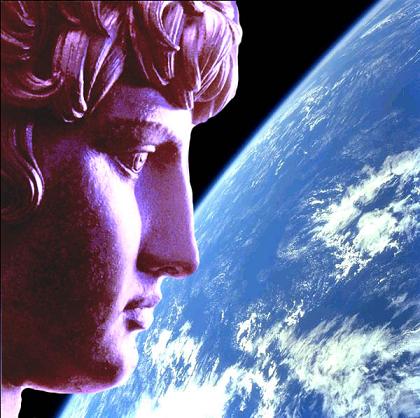
One of the things I love about our religion is that it spans the globe.
Check out the hundreds of members of the brotherhood of worshippers of Antinous which we call ECCLESIA ANTINOI and you see there are people in South Wales (UK) and New South Wales (Australia). There are people in Sao Paulo and Sydney. There are people in California and Cape Town, and there are some in Portland Oregon and Portland Maine.
For some of us the days are getting shorter and Winter is approaching. For others of us the days are getting longer and Summer is on the way.
For our brothers in Brazil and South Africa and Australia, the jacarandas are in bloom and the days are hot and balmy. Sydneysiders are bracing for another bush fire season.
For our brothers here in Britain and Europe (where I live), the days are short and almost completely sunless and the scent of roasted chestnuts and mulled wine fills the air from vendors on city streets.
For our brothers in the US and Canada, ice storms and the icy fear of economic disaster have put a chill on this Solstice Season.
Wherever we are, regardless of the season, Antinous the Gay God looks into our hearts.
And it is all happening at this magical moment. Twice a year there is a moment -- in fact, a few days -- when the sun seems to "stand still" in the heavens. From the Latin "sol stasis" we derive our name for these events: solstices.
That's the very odd thing about this blue marble upon which we live. The Solstice occurs at the same moment everywhere. But the hands on the clocks point to 23 different hours. And in some places it signals the start of summer (though the days start getting shorter), while in others the it signals the start of winter (though the days start getting longer).
But it is really the same moment and we are all living and breathing at this same moment, though we live in places where the hands of the clock point in all different directions. Each of us is alone. All of us are together in this aloneness.

It is the moment of Antinous-Narcissus. And this is the cue for Arch Priest Antonyus Subia to wax eloquent about the Antinous Mystery Teachings revolving about the phenomenon of the December Solstice. It is the Three-Fold Mystery Teaching about how the Lone One begets the Three-Fold Divinity:
"The return of the sun is the Conquest of Unconquered Light over chaos and darkness, the emergence of Phanes-Eros-Dionysus from the cosmic egg. On this day, we observe the moment when the unknown god Bythus-Narcissus gazed into the pool of the abyss and saw his own reflection. His image caused the birth of the thrice-great Phanes-Eros-Zagreus, the saviors, who together are called Antinous Invictus. The three-fold mystery of their birth is the descent of Phanes-Beauty, Eros-Love and Zagreus-Ecstasy into our world. These great spirits are the divine light of Antinous the God, it is their presence at the ground of our soul that is our immortal spark. Within us all is the perfect image of the perfect face of light and love, a reflection of Narcissus-Bythus gazing down into the darkness of our world."
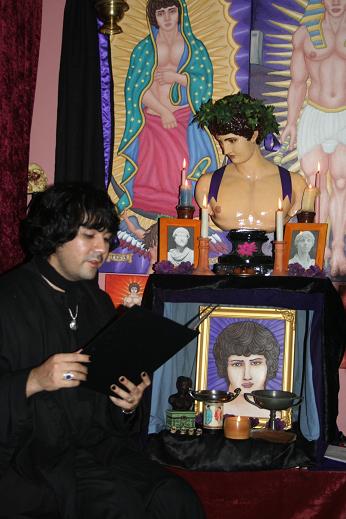
And then, Antonyus tells us, the One who begets the Three then becomes the Many:
"In celebration of the return of Antinous Invictus, for the five days between December 25th and the 1st of January, we commemorate the Golden Age of the reign of Saturn. This is a time outside of time, and an occasion for joy and freedom from the world. The divine twins are born, Osiris and Isis, Set and Nephthys, Castor and Pollux, Freyr and Freya (for whom this time is also known as Yule). We celebrate the Saturnalia with indulgence and as the festival of Liberty and total Freedom. There shall be no authority and no submission during this sacred period. There is to be no war, and no form of violence committed, only peace and harmony and the many joys of ecstasy are allowed. The rejoicing of the Saturnalia ends when the Prince of Flowers, Aelius Caesar, dies at midnight on December 31st."
It starts with the December Solstice.
Our brothers are scattered across all seven continents. They come from all racial and ethnic backgrounds. They come from all walks of life. Some are well off while others live in grinding poverty. Some are successful both in terms of material wealth and in love. Others lead lives of quiet despair. Some are blessed with youth and health. Others wonder whether they will live to see the seasons change again.
For some of our brothers it is the Shortest Day of the Year. For others it is the Longest Day of the Year. It is the Winter Solstice but it is also the Summer Solstice. It is the same moment. And it is all moments. It is Winter. And it is Summer. It is Sunlight and Life. And it is Darkness and Death.
It is the Cycle of the Seasons. Change is the one constant in life on this blue marble. Change is the one constant in our lives. The dawn always follows the night. Spring and Summer always follow Autumn and Winter.
Just as the Earth turns and the Seasons turn, our lives are also perpetually turning. If we stop turning, we die. It is only through turning that we live. Letting yourself just turn with life is one of those "Simple Gifts" that the old Shaker hymn so beautifully expresses:
The Constellation of Antinous "died" in late October when the constellation merged with the sunset -- just as Antinous himself died in late October. Hidden by the glare of the sun, it is not visible during the December Solstice. But the Constellation of Antinous will surely emerge from the sunrise a couple of months from now and will begin its ascent into the skies, reaching its pinnacle exactly six months from now -- at the time of year called Summer in some places, and called Winter in other places.
It is the same phenomenon. But how you see it depends on how you look at it.
The days are getting longer. The days are getting shorter. It all depends on how you look at it.
However you look at it, remember that we are all brothers, lovers and comrades. And we are all turning, turning toward our own true delight.
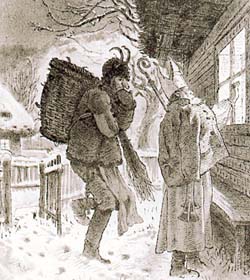
Those of you who are real card-carrying pagans probably know that today, December 5th, is the day in many parts of Central Europe when Santa's Dark Helpers are honored. Tomorrow, December 6th, is the Feast Day of St. Nicholas and it is the day when kiddies put out shoes or hang up stockings (the traditions vary from country to country) to receive gifts from Old St. Nick. That is when Santa rewards the children who have been nice all year.
St. Nicholas was born in the Asia Minor port town of Patara (modern Myra, Turkey), which had a renowned oracle at a temple of Apollo which, it is said, Bishop Nicholas tore down and replaced with the church which bears his name today. Patara was also one of the purported birthplaces of Apollo. St. Nicholas was never officially canonized by the Church. He simply usurped the popularity of Apollo and promoted his own reputation for being a protector and a giver of good things.
Throughout Eastern and Central Europe, customs dating back to Antinous/Apollo are mixed with Christian traditions. Cernunnos and Apollo still live in these folk customs. So it is that December 5th is the day when Santa's Dark Helpers roam the streets looking for naughty children who need to be punished.
In the English-speaking countries, we combined Santa and his helpers (the elves and reindeer) into a composite which arrives at Christmas time to stuff the stockings and reward children who have been naughty and nice.
But the pagan history shows that St. Nicholas is a vastly more complex being, stemming from the Temples of Apollo and Artemis in Asia Minor (the birth country of Antinous) which would later be the birthplace of the historical Nicholas.
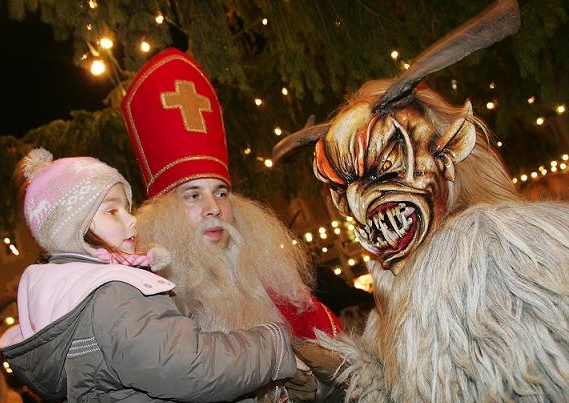
In many places in the Alps and in Central European countries such as Austria, Hungary, northern Italy, the Czech Republic and Germany, this Yuletide spirit being is a duality. Part of him is the kindly priest in flowing robes and part of him is the fiend with slashing teeth and claws.
Even schoolboys learn early on the fun of dressing up as Krampus. It really is the Central European equivalent of Halloween, and teenage boys "become" demons at this time of year.
On December 5th, it is the Christmas "fiend" or "demon" which prowls streets looking for unwary children to pester. In Holland he is called Svartze Piet (Black Pete or Black Boy) and he has other names in other countries. In Germany he is Knave Ruprecht. Most places he is called Krampus pronounced "KRAHM-POOSE".
And what Krampus does is all kind of a combination of Halloween Trick-'R'-Treat and Christmas caroling -- all of which are closely related ancient pagan customs.
In a kind of Yuletide Halloween, young men dress up in Krampus outfits. The costumes vary from one Alpine valley to the next. But generally they consist of fur pelts, Cernunnos-like horns and numerous cow bells, whips and chains. A werewolf-style mask has become popular in recent years, though Krampuses in earlier times made do with sooty faces.
Fueled by alcohol or other "Christmas spirits" (to ward off the cold, you see), these young men magically take on the personality of Krampus -- they roam the streets about sundown frightening children and demanding drinks from the neighbors. In larger cities there are proper Krampus parades down the main thoroughfare in the middle of town. But big town or little village, a procession of Krampus kritters is very intimidating even to grownups, not to mention small dogs, like this one in Arnold Schwarzenegger's hometown of Graz, Austria:
Whips, chains, birch switches and cow bells create a cacophany which echoes through the narrow streets. Add to that the aroma of roasted chestnuts and mulled spiced wine and you have a recipe for pagan merriment which bears only a passing resemblance to what most non-Europeans would call Christmas:
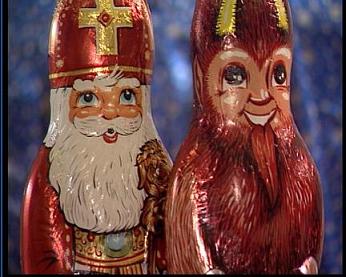
Alcoholic beverages, gingerbread, chocolate fondue and all sorts of baked goods are all part of the fun. For people in the Alps, the Yuletide season wouldn't be the same without a chocolate St. Nicholas AND a chocolate Krampus to go with him.

Krampus is a big merchandising gimmick. Alpine bakeries make Krampus turnovers in the shape of a horned demon and which are stuffed with delicious sweet mincemeat filling. Street vendors sell figgy-prune Krampus figures -- confections made of dried prunes and figs and nuts which are strung together onto wires so that they stand upright. I've seen some of these figgy-prune Krampus figures that were almost a meter tall (with coconuts for heads) and which were used as window displays in department stores in Austrian cities. A candy Krampus as tall as a man in a confectioner's window in Vienna was made entirely of pink spun sugar.
Later on the evening of December 5th, when all good boys and girls are snug in bed, Krampus and his cohorts go on a drunken rampage of attacking people with burning torches. They run in packs through the streets of small Alpine towns, attacking "naughty" children and any woman who ventures out and of course they really get rough with other males:
Then on December 6th, St. Nicholas takes things firmly in hand and the horned Krampus cohorts serve as his escorts as they go from door to door in small villages playing a kind of Trick-'R'-Treat. Nice children get some candy from St. Nick and naughty children get chased around the living room by Krampus:
In many places, several different aspects of Santa process all together. St. Nicholas is joined by Christkindl (Kriss Kringle in English) who is an androgynous Apollo-like figure wearing snow-white robes and a gold crown -- and followed up by Krampus along with various angels and demons.
As Sacred Synchronicity would have it, I just got an email asking if it's true that Apollo and Cernunnos and Santa Claus are all related. Oh yes! It's too true!
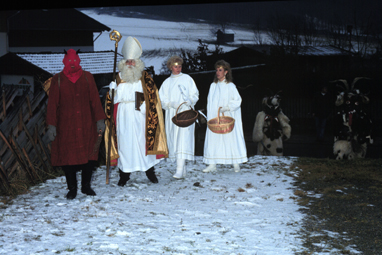
St. Nicholas was born in the Asia Minor port town of Patara, which had a renowned oracle at a temple of Apollo which alas no trace of which has been found. As I mentioned, Patara was also the birthplace of Apollo, or at least of his son Patarus by a water nymph called Lycia, from whom the whole region got its name -- Lycia.
The Patara Oracle was active in winter, when Apollo preferred the climate of the Turquoise Coast. In summer, Apollo moved back to Delphi.
In 245 AD Patara saw the birth of a boy called Nicholas, who anonymously gave his inherited wealth to needy children. St. Nicholas grew up and moved to the nearby town of Myra, which had a curious fish oracle devoted to Apollo.
According to Pliny:
"At Myra in Lycia at the fountain of Apollo whom they call Surius, the fish, summoned three times on a pipe, come to give their augury. If they tear the pieces of meat thrown to them, this is good for the client, if they wave it away with their tails, it is bad."
Atheanaios reports on the ceremony:
"I don't want to ignore the people of Lycia who know the art of the fish oracle. Of them, Polycharmus writes in the second book of his Lycian history. '...when they come to the sea, where is the grove of Apollo by the shore, on which is the whirlpool in the sand, the clients present themselves holding two wooden spits, on each of which are ten pieces of roast meat. The priest takes his seat in silence by the grove, while the client throws the spits into the whirlpool and watches what happens. After the spits are thrown, the pool fills with seawater, and a multitude of fish appear as if by magic, and of a size to cause alarm. The prophet announces the species of the fish and the client accordingly receives his answer from the priest. Among the fish there appear sea bass and bluefish and sometimes whales and sawfish and many strange and unknown kinds."
Plutarch and Artemidorus also offer similar accounts of the fish oracle ceremonies at the Apollo Surius temple.

Apollo's sister Artemis also had a cult center in Myra. Myra's main cult was dedicated to Artemis Eleuthera, a distinctive form of Cybele, the ancient mother-goddess of Anatolia. She had a magnificent temple in Myra.
Unfortunately, St. Nicholas, the bishop of Myra, was zealous in his duties as bishop and took strong measures against paganism. The temple of Artemis and the Apollo oracle were among many other temples in the region that he destroyed. It is said that the very foundations were uprooted from the ground, so complete was its destruction, "and the evil spirits fled howling before him".
St. Nicholas was never officially canonized by the Church. He simply usurped the popularity of Artemis and Apollo and promoted his own reputation for being a protector and a giver of good things. Antinous/Apollo more or less morphed into Old St. Nick, aka Santa Claus, Father Christmas, das Christkind and Kriss Kringle.
Supposedly he saved three young women from having to prostitute themselves by dropping bags of money anonymously through their window while they slept. In another version, three little boys had been killed by a pedophile innkeeper who dismembered their bodies and served them in a stew to his guests. Nicholas stopped by the inn, took one taste of the Three Boy Stew and instantly let out a cry to heaven which caused the boys to be restored to life intact right there on the spot.
There are numerous other stories about fish and boats and children being saved and also about thieves. Like Antinous/Hermes, St. Nicholas is the patron saint of thieves. He is the saint of prisoners, cut-throats and con men because he saved three convicted armed robbers from being executed.

The stories generally involve the number three and miraculous rescues and gifts given surreptitiously after fall of darkness.
So Antinous/Apollo, in the guise of Nicholas, later became Bishop of Myra and was respected for his humane approach to religion and as a protector of children and fishermen. He is still known as St Nick, Santa Claus, Sinter Klaas, das Christkind or Kriss Kringle. And in a lot of places, Santa has several dark and scary sidekicks.
They are all aspects of the composite spirit being who in English-speaking countries is called Santa Claus or Father Christmas. But the deeper you go back into Central Europe, the more differentiated this ancient being becomes so that you see his various component parts -- including Antinous-Apollo.
In the Nordic and English version, of course, all that is left of Krampus with his horns and hooves and fur is the reindeer which accompany Santa's sleigh.
Next time you see a department store Santa, just remember you are seeing only a composite being whose multitudinous composite aspects (many of them very dark and spooky) trace their origins back to the beginnings of mankind. If you look very, very carefully, you will see the face of Antinous/Apollo shining through the centuries of folk customs.

The Moon was aligned with the STAR OF ANTINOUS on election day in the US (a month ago today), and President-Elect Barack Obama has taken decisive steps since then to make good on his campaign motto "YES WE CAN."
Our own Arch Priest Antonius (who is himself Hispanic) as well as the rest of us who are Priests of Antinous are reminded during this presidential transition period of ethnic-minority born Hadrian, the provincial bumpkin with the comical accent -- a man who had made Patrician Romans laugh with derision at the thought that he might ever become emperor. But Hadrian dared to hope that he might become emperor. And he had a dream of consolidating the Empire's borders and of fostering an civilization based on Hellenistic principles of tolerance and cultural diversity.
It is gratifying to see that others also draw parallels between Obama and the Divine Hadrian. Millions of listeners in the US last night heard an insightful commentary on the National Public Radio (NPR) news analysis show "All Things Considered" which spelled out those Obama/Hadrianic parallels in striking detail. The commentary was by NPR's Guy Raz, who is on sabbatical as a Nieman fellow at Harvard University, where he is studying ancient history. In case the link below is outdated by the time you click on it, I have repeated the commentary in full (at bottom) although, for fairness's sake, you really ought to click on the NPR website for this and other insightful news and analyses.
It is important to remember that Hadrian was Hispanic -- literally so. He was born in the province of Hispania and spoke with a provincial "Hispanic accent" which was the cause of much mirth when he was sent to Rome as a boy to be educated. Like a lot of sensitively aware gay men, he lost his cornpone accent and carefully created an image of himself as a cultivated person of letters. Just as Obama's intellectual horizons were expanded at Harvard, it was Hadrian's studies in Athens which helped to give him a vision of a world unified by a love of Hellenistic values -- the love of learning, the arts, philosophy -- and of interconnectedness.
Rome in the 2nd Century CE had become a multi-culturally diversified empire. Patricians still clung to power in Rome, but the Empire itself was firmly in the hands of "non-Romans" who had no blood ties to the old founding families of Rome and who had often enough never even been in Rome.
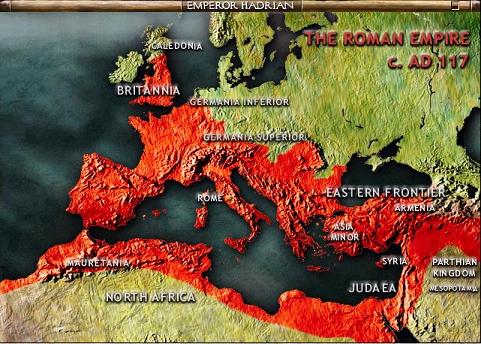
Hadrian was keenly aware of the cultural metamorphosis occurring around him. Hispanic-born, he was part of that metamorphosis. Like Obama, Hadrian faced the challenge of attempting to guide the swirling waters of change into constructive channels and to avert flash-flood destruction.
Hadrian was described by Suetonius as "always in all things changeable". So we can assume Hadrian would have concurred with Barack Obama's motto of "hope" and "change you can believe in".
And also like Obama, Hadrian was a symbol of the diversification which was transforming the Roman Empire from a city-state ruled by Patrician families into a sprawling yet interconnected and interdependent empire spanning the civilized world.
Hadrian had a vision of a peaceful and prosperous world unified by the Hellenistic spirit of interconnectedness -- the spirit which he imbued into the RELIGION OF ANTINOUS, into which he invested all his spiritual goals for a perfect religion based on beauty and love and tolerance.
After coming to power, Hadrian spent most of the next 20 years as emperor on journeys throughout this sprawling empire. He was only seldom seen in Rome. He was determined to promote his vision of a Hellenistic world throughout his reign and throughout his empire. He was determined to give people in the far-flung provinces a feeling of interconnectedness. His goal was to make them care about the welfare of the Roman Empire because it was THEIR empire. Having been born in Hispania, he knew how it felt to be disconnected and to live in the vacuum of the provinces.
Hadrian's vision is the same vision that propelled Obama to the presidency in the US. It is the vision of making everyone feel connected and to have a feeling that they can dare to hope for change.
There are times when we all feel disconnected from the world. Our actions seem like they are of no major consequence, and we feel like we exist in our own vacuum.

Yet, Hadrian (and Obama) dared to champion the truth. And the truth is that our simplest thought or action -- the decisions we make each day, and how we see and relate to the world -- can be incredibly significant and have a profound impact on the lives of those around us, as well as the world at large.
The earth and everything on it is bound by an invisible connection between people, animals, plants, the air, the water, and the soil. Insignificant actions on your part, whether positive or negative, can have an impact on people and the environment that seem entirely separate from your personal realm of existence. Staying conscious of the interconnection between all things can help you think of your choices and your life in terms of the broader effect you may be creating.
An encouraging word to a young gay person about their special talent can influence this person to develop their gift so that one day their art or their inventions can change the lives of millions.
An office shrine to Antinous (even just a photo) or a tattoo or an Antinous bumper sticker can inspire other gays in distant places. A poem written "merely" to express oneself can make a stranger reading it online from thousands of miles away feel less alone because there is someone else out there who feels exactly the way you do. Even a middle-aged old queer can stand up -- as Saint Harvey Milk did in his forties -- and become a beacon of hope and inspiration for others by saying, "Yes We Can!" when the Proposition 8 majority has told you "No You Can't".
Staying conscious of your connection to all things can help you think of your choices in terms of their impact. We are powerful enough that what we do and say can reverberate through the lives of people we may never meet.
Understanding that you are intimately connected with all things -- because even one vote counts -- and understanding your power to affect our world can be the first step on the road to living more consciously.
That is "change we can believe in", to use Obama's campaign slogan.
Hadrian, who was "always in all things changeable", would share that vision of "hope" and "change" for a world interconnected by a love of Hellenistic values of peace, prosperity, learning, beauty and tolerance. Those Hellenistic values are the Heart and Soul of the religion in founded in the name of his Beloved Boy -- THE RELIGION OF ANTINOUS.
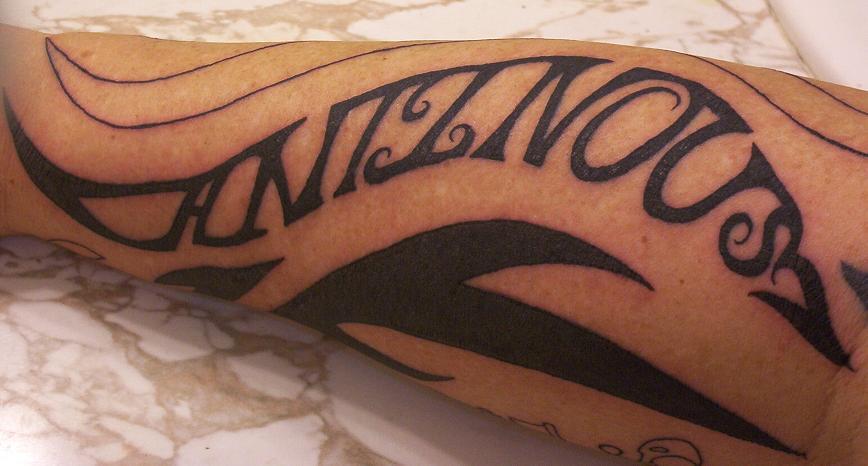
NPR "ALL THINGS CONSIDERED" December 2nd, 2008
Commentary by GUY RAZ
When he takes office in January, President-elect Barack Obama will inherit the gloomiest economy since the Great Depression, prompting comparisons to another president who came into office during tough economic times: Franklin D. Roosevelt. But there's another leader Obama could draw inspiration from — a 2nd century Roman emperor.FAMILIAR CIRCUMSTANCES
The world's most powerful army was bleeding in Iraq. An easy invasion five years earlier had quickly turned into a deadly guerilla war. Tens of thousands of soldiers had already been killed by insurgents. The corpses of many more civilians and insurgents littered the deserts of Mesopotamia.
The war was expensive. The government that had sent the army to the Middle East now faced a crushing debt. The economy was foundering. Elsewhere in the known world, that same army — stretched to its limits — struggled to provide enough manpower to keep a lid on three other rebellions.
The year was A.D. 117, and the exotic young man who was about to assume the leadership of the Roman Empire wasn't born in the capital city, but in modern-day Spain.
His name was Hadrian. And the empire he inherited from his predecessor Trajan was — militarily, economically and diplomatically — in a precarious position.
LEADERS ACCUSED OF ARROGANCE
At the time, Roman legions were fighting rebellions from the western corner of north Africa all the way to the Tigris River.
The people who lived under Rome's sphere of influence in Gaul and along the Danube complained that their grievances weren't being heard. And they accused Rome's leaders of arrogance.
So Emperor Hadrian, faced with challenges at home and abroad, decided to do three things.
The first decision was to withdraw his legions from Mesopotamia. He decided to shrink and then consolidate the borders of the empire.
The next was to shift money from the war in the east to deal with the public debts. He even found some extra cash to boost the economy with a massive public infrastructure project — things like repairing aqueducts, roads and bridges.
Finally, Hadrian did what few of his predecessors would even consider: He went on a road trip and visited nearly every corner of the empire. He knew that for Rome to bolster its influence, it had to show at least some respect for the nations so affected by its power. Hadrian also increased foreign aid and started a program of nation-building throughout the empire.
By and large, it worked.
AN UNPRECEDENTED FEAT
Now, judging by modern-day standards, Hadrian was brutal. He crushed a Jewish rebellion, killing thousands, and very nearly abolished the Jewish faith. (He saw the Jews as a threat to the stability of the empire.)
But considering that he reigned for two decades, Hadrian's era was remarkable for the virtual absence of war — an unprecedented feat for a Roman emperor up to that point.
By the time he died in 138, Hadrian's Roman Empire had become more peaceful — and powerful — than at any other time before or after.

Gus Van Sant's biopic "Milk" leapt into the Top 10 box-office hits during its opening weekend across the US and Canada.
That is extraordinarily good, considering that the movie was given only limited release and that it was up against a number of blockbusters -- all vying for the top spot over the US Thanksgiving holiday weekend.
According to the Associated Press, this year marked the second-biggest Thanksgiving ever for Hollywood. The Thanksgiving weekend (Wednesday through Sunday) traditionally is the start of the Christmas holiday movie releases in the US and Canada. Christmas-theme movies are usually released then.
The Reese Witherspoon/ Vince Vaughn holiday comedy "Four Christmases" topped the box office over the Thanksgiving weekend, opening at No. 1 with $31.7 million.
Director Baz Luhrmann's long-awaited epic "Australia" (which, as a "Baz fan," I can't wait to see) was the weekend's other new wide release, opened at No. 5 with $14.8 million for the weekend and $20 million since debuting Wednesday. The World War II-period romance stars Nicole Kidman and Hugh Jackman.
Against that backdrop, it is almost incredible that "Milk" got into the Top 10 at all, considering it was released only at selected art cinemas, and not at multiplexes.
It opened at No. 10 with $1.4 million in just 36 theaters.
Hollywood pays enormous attention to these box-office figures. The fact that a political movie about a gay activist who gets killed could do so well against Christmas holiday movies -- well, that is something that will encourage studios to take more risks in the future with gay-theme movies.
Those of you who saw the movie this past weekend have put your money where your mouth is -- and have helped to show straight movie execs that there is money to be made with movies like "Milk."

The RELIGION OF ANTINOUS honors Harvey Milk as a Blessed Saint and Martyr. His Saintly Feast Day is November 27th, which is not only the day he was assassinated in 1978 -- it is also the day that Gus Van Sant's critically acclaimed film was released this past week.
Champion of the early gay rights movement, in 1977 Harvey Milk became the first openly Gay person to be elected to the Board of Supervisors in San Francisco. He advocated the liberation of homosexuality for the benefit of society in general, and jokingly claimed to be a gay recruiter.
He was instrumental in passing the Gay Civil Rights Bill in San Francisco, which was to be his undoing.
Exactly 30 years ago -- on November 27th, 1978 -- Saint Harvey was assassinated in City Hall along with Mayor George Moscone by former City Supervisor Danny White, who had resigned his office after the enactment of the bill. Danny White was sentenced to only seven years.
News of the assassinations spawned bloody riots by enraged gay people in front of City Hall. Subsequently, 100,000 people marched on Washington in support of Gay Rights, chanting "Harvey Milk Lives!"
He became the first gay saint and martyr following the movement that began at the Stonewall.
In a tape recording made one year before his assassination, as if in prophecy, Harvey Milk said:
"If a bullet should enter my brain, let that bullet destroy every closet door."
For his actions, for his life, for the changes that he effected, and for the love that continues to burn for him in the memory of his gay, lesbian and transgender children, we priests of the RELIGION OF ANTINOUS recognize and sanctify Harvey Milk as a Heroic Saint and Martyr.
It brings joyful pride to our hearts to see that Saint Harvey has become a rallying point in the revived spirit of Gay Rage (and Outrage) in the wake of the Proposition 8 debacle in California.
Here is the top 10 list, from the AP:
1. “Four Christmases,” $31.7 million.
2. “Bolt,” $26.6 million.
3. “Twilight,” $26.4 million.
4. “Quantum of Solace,” $19.5 million.
5. “Australia,” $14.8 million.
6. “Madagascar: Escape 2 Africa,” $14.5 million.
7. “Transporter 3,” $12.3 million.
8. “Role Models,” $5.3 million.
9. “The Boy in the Striped Pajamas,” $1.7 million.
10. “Milk,” $1.4 million.
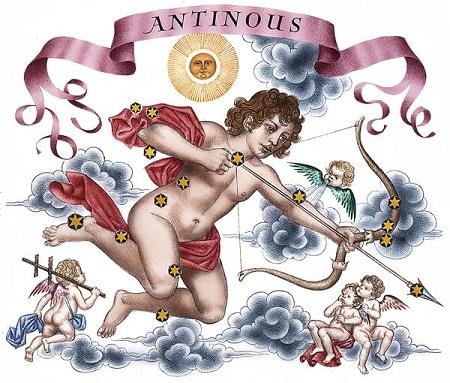
December 1st is the day in our Liturgical Calendar when we worship THE NEW STAR OF ANTINOUS -- actually it's not just one new star, but rather all the new Novas and Super Novas which occur in the Constellation of Antinous with regular frequency.
Grief-stricken Hadrian discovered one such new star in the Constellation of the Imperial Eagle (Aquila) a short time after the death of his Beloved Boy. He proclaimed it THE STAR OF ANTINOUS and declared it to be the Prime Fixed Star of the CONSTELLATION OF ANTINOUS.
As Sacred Synchronicity would have it, the waxing moon (whom we adore as the face of ANTINOUS THE MOON GOD) is in perfect alignment on December 1st, 2008, with the STAR OF ANTINOUS in the ancient zodiacal sign which bears His divine name -- though it is no longer recognized by astronomers, and only a handful of astrologers have more than a passing acquaintance with the Fixed Star Nature of the STAR OF ANTINOUS and his Celestial Sign.
December 1st, 2008, is also special because the moon is in a very rare and very spectacular conjunction with the planets Jupiter and Venus.
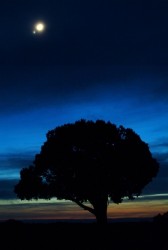
Look up into the nighttime sky on December 1st and see the moon, Jupiter and Venus as they converge on a tiny patch of sky no bigger than the end of your thumb held at arm's length. The three form a trio so tight and eye-catching, it may take your breath away -- especially when you realize that both are in almost perfect alignment with the STAR OF ANTINOUS (just a hand's breadth above them).
Perhaps it is similar to the celestial sight which the Divine Hadrian saw from his custom-built observatory at the Villa Hadriana outside Rome as he scanned the nighttime skies in search for a Sacred Sign from his Lost Love. He was looking for a New Star in that segment of the heavens where the occult experts in Fixed Star Astrology say the stars are blessed with Astrological Natures reflecting Jupiter (the Emperor) as well as Mars and Venus (the Lovers who combine Masculine/Feminine energies).
As we look aloft on this special night, perhaps we are witnesses to something akin to what Hadrian saw -- the merging of Jupiter and Venus and the Moon. And perhaps we are witnesses to clues to the origins of the Mystery Teachings of the STAR OF ANTINOUS as well as to the origins of the association of Antinous with the Moon.
On that night so long ago, perhaps Mars was also prominent in the nighttime sky, for the STAR OF ANTINOUS is almost unique among Fixed Stars in that it combines the Astrological Natures of Jupiter, Mars and Venus -- an extraordinary combination of joyful expansiveness, sexual hotness and yet gentle emotional beauty.
The STAR OF ANTINOUS rules all homosexuals, and its position in a Natal Chart says much about the Astrological Nature of a gay person.
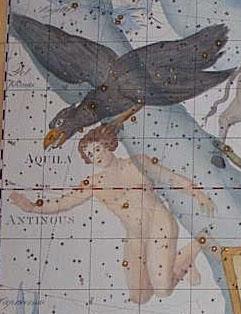
On December 1st, however, we are not so much honoring the STAR OF ANTINOUS as we are honoring all the many new stars which occur with regular frequency in the ancient Sign of Antinous, owing to the fact that the "hub" of the Milky Way Galaxy is almost directly behind Antinous. On star charts, Antinous seems to be kneeling on the banks of the Milky Way as it flows past him -- like the Nile in which he drowned -- as the Imperial Eagle hovers over him protectively.
Novas and Super Novas flare up with a starburst of light in this region of the heavens every few years. There was one big Super Nova on December 1st, 1999, ( Nova Aql 1999 ) and there have been others since then.
And just a few weeks ago, our own Arch Priest Antonyus announced that yet another Nova had been discovered on the night of the September Equinox by a Japanese astronomer. He called it V1721 Aql (Nova Aql 2008). It is about a hand's breadth above and to the right of the Moon on December 1st.
We honor all of these New Stars of Antinous on December 1st, the anniversary of Nova Aql 1999.
In announcing the new 2008 Nova, Arch Priest Antonyus told the worshipers of Antinous the following:
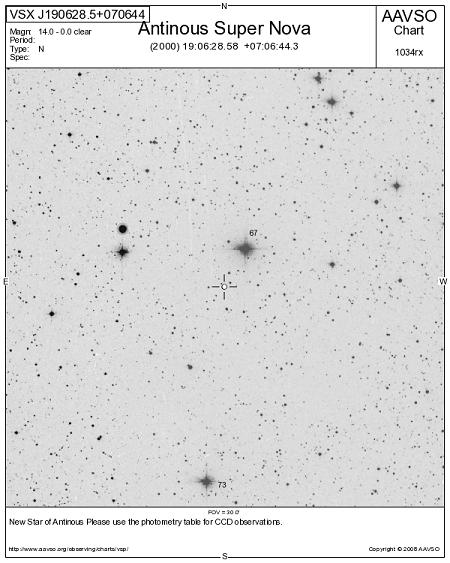
"My belief is that the STAR OF ANTINOUS was a super nova...a brilliant new star visible with the naked eye, and very likely of a magnitude that must have made a considerable impression, not your ordinary new star, but a very powerful new star...a Super Nova, rather than a nova of the somewhat more common sort, which are those that cannot be seen with the naked eye, and are only detected by keen eyed astronomers.
"There is a region of the constellation Aquila/Antinous that is splendorously rich in Nova stars, they occur there about once or twice every decade. The brightest Super Nova ever recorded since Johanas Kepler's Super Nova of 1604, was discovered in 1918, in the constellation Aquila/Antinous...from what I can tell, it was so bright that it outshown Sirius, and all the planets...it was the brightest star in the sky that has ever been officially recorded. The brightest star that modern astronomy has ever actually seen was in our own Constellation of Aquila/Antinous.
"Whatever it was that Hadrian saw...it might not have been more brilliant than the Super Nova of 1918, brightest star ever recorded. Like the latest Nova 2008, it might not have been easily discernable to laymen, only to trained experts. The historian Dio Cassius scoffed at Hadrian and sarcastically tells us that:
"'Finally, he declared that he had seen a star which he took to be that of Antinous, and gladly lent an ear to the fictitious tales woven by his associates to the effect that the star had really come into being from the spirit of Antinous and had then appeared for the first time.'
"And yet, much evidence points to a gigantic super nova, or even just a lesser super nova, visible to the naked eye, but not so powerful as as to surpass Sirius and the planets, but obvious to the common nighttime observer that something different has occurred in night sky...something never seen before, and yet, not obvious to the common observer, like a Super Nova...unless it were one of the few Mega Super Novi that can even be seen in the day time.
"But even if it were just less than that -- the brightest star in the sky --- the general populace would think nothing of it (as Cassius Dio thought nothing of it), but the astrologers would think the world of it, because they would have been the only ones to notice.
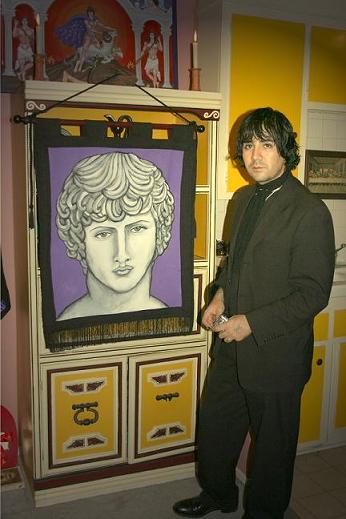
"From what has been observed in the last 150 years (there were more Nova Aquilae in the 1800s) the constellation Aquila/Antinous is a very active and volatile region of the the sky...which leads me to one conclusion.. .that it is more likely that THE SACRED STAR OF ANTINOUS was a Super Nova...a fabulous stellar occurrence, that was visible with the naked eye to EVERYONE...( there was a super nova in 1556 that was visible at midday or so they say).
"Hadrian would not have proclaimed the Spirit of Antinous to have taken his place amoung the stars of the celstial sphere, had there not been a very good, and obvious reason to have made such a proclamation. A super nova such as the one that occured in 1999 is a great example of a new star that even the ancients, without the aid of telescopes, would have noticed, and would have considered a significant celestial event.
"And now in 2008, shining in the night sky above us all is a New Star..they say that it is Red in color...like a tiny ruby that only far-sighted telescopes can see...but there it is all the same...a new star in the contellation Antinous."
New stars flare up all over the heavens all the time, of course. But Hadrian was looking for a celestial confirmation in THIS part of the heavens, where the qualities of Jupiter, Venus and Mars would signify the Spiritual Nature of ANTINOUS THE GAY GOD.
It is a modern popular misconception that the ancients named the constellations after certain animals or mythical beings because they thought they could see the shapes of animals or people in the star designs.
That's nonsense, of course. I mean, have any of you ever seen anything looking like a swan or a dog in the stars? You may pick out Orion and Ursa Major (what Americans call The Big Dipper). But have you ever seen any recognizable figures? Of course not. The ancients couldn't see any figures either. What they saw were Sacred Synchronicities.
The real reason for the constellations was explained best by the brilliant Fixed Star astrologer Vivian E. Robson nearly a century ago:
"The original constellation figures are all traditional and have been a source of annoyance to modern astronomers, who have naturally failed to trace among the stars the slightest resemblance to the objects they are supposed to represent. To those actively engaged in a study of stellar and constellation influences, however, it will soon become apparent that these seemingly fanciful shapes are in reality a fair representation of the collective influences of the stars contained in them, and that the constellation of the Dog, for example, actually influences dogs, ridiculous as it may appear."

The ancients believed that each constellation had different "regions" which had a special "flavor" or "nature" which might be different from other parts of the same constellation.
Hadrian wasn't looking for an outline in the stars. He was looking for a Sacred Synchronicity.
That is why our own Antonyus is so excited about the new Nova in the same region of the sky a few weeks ago. Any Nova in this small corner of the sky has a Sacred Synchronicity for all of us. It doesn't matter that you can't see it with your physical eye. There is nothing to see with your bodily eye. You can only see it with your Spiritual Heart.
The ancients knew how to "find" these Sacred Locations. They knew all about "divine soil" and "sacred stars." It is a knowledge which our civilization has sadly lost -- alas!
Our own Priest Uendi Hommel has created a wondrous YouTube video about the Mystery Teachings of the STAR OF ANTINOUS. Aside from being the first female Priest of Antinous in recorded history, Uendi is a scholar in archaeology as well as being a professionally trained artist, and her Sacred Art is expressed beautifully in the short film below.
Don't despair if you can't find the STAR OF ANTINOUS. Don't worry if you cannot see any stars at all because you live in a large city. The STAR OF ANTINOUS is not necessarily something you see with your physical eyes. Just look up and REMEMBER Antinous. Remember the Bithynian Boy who was born 1,897 years ago and who lived and walked on this Earth, who ate and drank and laughed and who loved to play and to hunt and who captured the eye of the Imperial Eagle one day -- and captured the Heart of the Divine Hadrian.
And after he died on October 28th of the year 130, his grief-stricken lover looked up into the nighttime skies through tear-filled eyes and discovered a new star which was a Sacred Sign.
Look up into the nighttime skies on December 1st and think of Hadrian and of his Beloved Boy -- the mortal youth who died and whose star represents his Sacred Ascension as a God of Love and Beauty and Healing Magic.

The Religion of Antinous has many solemn holidays such as the Death of Antinous. But we also have the Birth of Antinous which we celebrate on November 27.
November marks the start of the ancient pagan Festive Season, a season which is still full of fabulous party dates -- including Christmas, New Year's Eve, Twelfth Night and of course American Thanksgiving. Dia de los Muertos and Halloween usher in this Festive Season of twinkly lights and over-eating and drinking way too much.
These ancient festivities go back WAAAAY before Christianity, of course. So it's a safe bet that Hadrian and Antinous would recognize many of the features of these festivities
So when you plan your Antinous Birthday Party, you can mix-and-match customs from all sorts of pagan Festive Season holidays, in full knowledge that Hadrian and Antinous would nod in approval.
Here's how I envision the Birthday of Antinous:
It should be celebrated with feasting and drinking and singing and carousing. Pine boughs should decorate the feast room in honour of the pine forests of Bithynia, the highlands of modern-day Turkey where Antinous was born. Electric lights should be turned off in favor of candlelight or at the very least those strings of tiny "fairy lights" which Moslems use during Ramadan and Hindus during Divali and Christians at Christmas
The one really bright spot in the room should be a bust or image of Antinous, which is spotlighted, signifying our belief that Antinous brings light into the world.
The Antinous Red Lotus would be perfect. But since not everyone has access to lotus blossoms in late November, orchids would also be fine. The orchid takes its name from the Greek word "orchis" which means "little boy's testes" for obvious reasons:

Hadrian and Antinous would have known this. Antinous would have seen wild orchids in the piney woods of Bithynia as a boy
Orchids would be lovely as well as being a Hellenistic conversation piece. If they are too pricey, then your favorite seasonal flower will do. Look around and find something that is beautiful and unique to your own locale which you think would be very nice.
The Birthday of Antinous would be a wonderful opportunity for a costume party, also in keeping with the Halloween/Carnaval/Christmas flavor of these ancient pagan holidays. Guests might be encouraged to come as Greco-Romans or Egyptian priests.
The menu could be Mediterranean, with lots of finger foods such as tahini and couscous and humous and pita bread, stuffed olives, eggplant/aubergine, goat's cheese and so on. Refried beans (which the Egyptians call "fuul" and eat for breakfast) would be ideal since the theory goes that the Moors introduced "fuul" to the Spaniards, who introduced it to the New World.
But you should feel free to go local with favorite regional dishes of your home area. There must be lots of good Cajun dishes which would be perfect, or Scottish specialties, or Aussie barbecued prawns or New England pot pies -- good simple "plebeian" food which is festive and spicy and filling.
In keeping with these pagan festivals, foods should represent birth and regeneration: beans, peas, black-eyed peas, pumpkins, squash, nuts, berries.
It doesn't really matter what food is served, of course, as long as it's delicious and plentiful, and as long as there is plenty of drink to wash it down, wine or beer or just good old iced tea.

Beer is quite appropriate, since the Ancient Egyptians were brewing beer thousands of years before Antinous was born. The Egyptians still produce a very nice light lager called Stella beer which has the advantage of having a star on its label reminiscent of the STAR OF ANTINOUS.
Just imagine: Antinous' last meal may have been refried beans and beer and flat bread.
You think I'm joking, but when celebrating the Birth of Antinous, I think we should be creative and try to think of what he would might have enjoyed eating and drinking.
Here's a very good idea, if I do say so:
In a change from holiday cakes and cookies, how about baking Antinous cookies? Bake simple sugar cookies which have been cut out to resemble stars, comets, an imperial crown and Bithynian fir trees and lions and so on and decorate them with Antinoian lettering or symbols.
Instead of gingerbread men, make gingerbread Antinouses. The gingerbread man, after all, is thought to come from pagan rituals for honoring Thor or other gods. Generally, they are sweet dough which is filled with a nut-date-spice filling representing rebirth and spiritual sustenance. You still find them today on St. Nicholas' feast day throughout Europe.
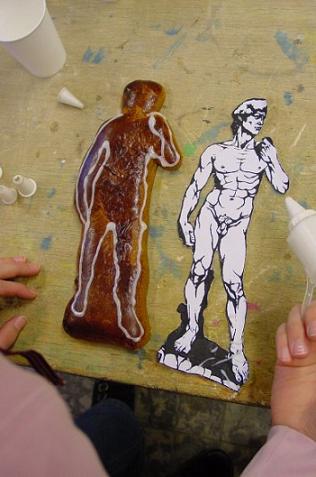
Or how about an Antinous Birthday Cake? Just look at one of Antonyus Subia's medallions and you have the ideal pattern for icing a really wonderful cake.
Whatever you bake, make sure to include a small "surprise" somewhere in the cake or muffin or cookes for some lucky guest to chomp down on. It doesn't have to be a diamond ring, but a trinket of some sort is always fun. And the risk of chipping a tooth or gagging on a sharp object invariably adds to the merriment of the evening. If that is too challenging for your skills as a confectioner, then just an ordinary cake with the letters "A-N-T-I-N-O-U-S" in store-bought candy lettering would do the job just as nicely. Or just a large "A" in icing in the middle of the cake. Even I might be able to manage that.
Another tradition should be oracle games. This is the first major festival of the New Year in the Antinoian liturgical calendar, so oracles are appropriate. Here in Europe (where I now live) there's a lead oracle game which is a tradition on New Year's Eve. It costs very little. You buy a kit with about half a dozen pellets of lead and a cheap spoon.
Everybody is seated around a table in the center of which is a bowl of water. Each party guest gets one lead pellet. One after another, the guests place their pellet in the spoon and hold it over a candle flame until the lead melts. Then the guest pours the molten lead into the water, where it instantly cools in a cloud of fizzing steam.
Afterwards you retrieve the cooled-off clump of lead and attempt to decipher the "occult" meaning in its twisted form.
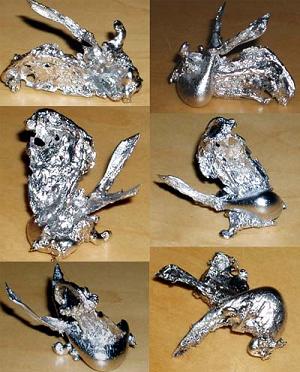
You can't imagine how thrilling it is to have a bunch of tipsy guests slinging spoonfuls of molten lead around a dinner table decorated with dozens of blazing candles and tinder-dry pine boughs. You don't have to have an oracle to foresee that the evening is fraught with all sorts of possibilities.
You think I'm being sarcastic. I'm not. I sincerely believe the Birthday of Antinous should be a pagan holiday which combines the best pagan traditions for fun and merriment, traditions for sharing food and love.
And when your guests suggest you are robbing traditions from Christian festivals, just look them square in the eye and insist that the Christians stole these wonderful traditions from us pagans because the Christians didn't have any of their own. Where would Christian holidays be without pagan traditions?
Who knows? Perhaps Hadrian and Antinous enjoyed these very same pagan traditions in their Saturnalia revelries.
Oh, one more thing: Mistletoe. Mistletoe is plentiful in the forests of Bithynia. Antinous would be well familiar with mistletoe. I'm sure he would like it as a reminder of his boyhood hikes through the woods of home.
Use your imagination and you'll come up with lots of ideas.
Let the Festive Season Begin with an Antinous Birthday Party!

ALL RIGHTS RESERVED
PERMISSION MUST BE GRANTED BY THE AUTHOR FOR USE ELSEWHERE